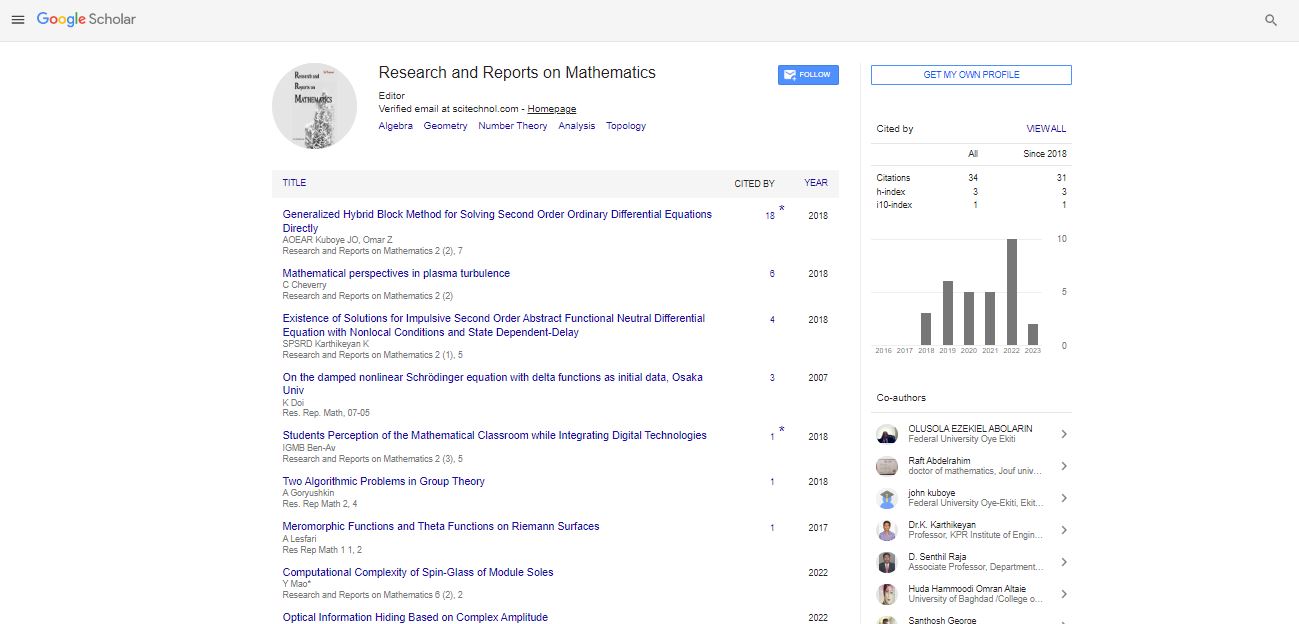Commentary, Res Rep Math Vol: 5 Issue: 8
Intertemporal Selection and Its Anomalies
Alexandre Emerick*
Department of Mathematics, Norwegian Research Institute (NORCE), Norway
*Corresponding Author:
Alexandre Emerick
Department of Mathematics, Norwegian Research Institute (NORCE),Norway
E-mail: Alexandremerick@ hotmail.com
Received Date: August 09, 2021; Accepted Date: August 20, 2021; Published Date: August 27, 2021
Citation: Emerick A (2021) Intertemporal Selection and Its Anomalies. Res Rep Math 5:8. 122.
Copyright: © All articles published in Research and Reports on Mathematics are the property of SciTechnol, and is protected by copyright laws. Copyright © 2021, SciTechnol, All Rights Reserved.
Keywords: addiction, retirement planning, health maintenance behaviors
Commentary
This special issue on “Intertemporal selection and its anomalies” collects the latest work on the subject from different research disciplines: behavioural economics, informatics, mathematics, cognitive and cultural psychology, behavioural ecology and economic physics. This question shows that research on intertemporal selection and its anomalies has been extended to important research activities outside the field of traditional economics.
In economics, intertemporal selection has been modelled as the concept of time preference, and the rationality of intertemporal selection (that is, temporal coherence) has also been assumed. Even without considering the violation of time inconsistencies, this conceptualization can help investigate various social issues, such as addiction, retirement planning, and health maintenance behaviors. The latest developments in behavioural economics show that once irrationality is seriously considered in intertemporal choices (such as hyperbolic discounting or lag effects, sign effects, amplitude effects, lag acceleration asymmetry and sequencing effects, etc.) It is seen as a self-control problem that manifests itself in intertemporal selection.
This question shows that the behavioural economics method of self-control in intertemporal selection has attracted widespread attention in various scientific disciplines. The editors are very happy to see that people’s interest in a wide range of research fields continues to expand, and we expect this movement to accelerate over time without compromise.
Kokura and so on. Introduce a model in the field of feed ecology, which predicts that the profitability of smaller feed options (SS) may be greater than the profitability of larger and later alternatives (LL), depending on the continued monopoly of producers Time for a piece of food. His article includes numerical simulations of the hypothesis that the amount of food in each patch is variable, which means realistic behavioural parameters.
Cruz Rambaud and Sánchez Pérez revealed that in the context of UE and DU models, there are several anomalies or paradoxes that affect the number of rewards: the peanut effect and the amplitude effect, respectively, which seem to develop in opposite directions. His article jointly analyses the two effects in a broad environment involving low-risk options and over time, looking for the effects between the two anomalies.
On the other hand, Cruz Rambaud et al. The concept of mathematical formalization of enhanced sequence effects. More specifically, they proved that the enhanced sequential effect of monetary rewards must be rationalized by using an inseparable discount function. In addition, under certain conditions, they proved that delay and amplitude effects are necessary (but not sufficient) conditions to enhance the existence of sequence effects.
Tsuruta and Inukai aim to assess the role of intertemporal decision-making in groups. By clarifying who has the greatest influence on group decision-making among heterogeneous group members, they experimentally studied how to aggregate personal time preferences. They put forward two hypotheses: the multilateral negotiation hypothesis based on the multilateral negotiation model and the intermediate voter hypothesis. The main contribution of this paper is that in the case of unstructured negotiation, the average membership of patients in a group has a significant influence on group decision-making.
Drawing inspiration from the special theory of relativity, Dos Santos and Martinez deduced inconsistencies due to the perceptual effect of subjective time dilation. By proposing a conversion of the time interval between the payment times of two rewards, they focused on a generalized model that contains the psychophysical impact on the perception of time. Therefore, they proposed a generalized twoparameter hyperbolic utility function of the Bernoulli (logarithmic) function.
Takemura and Murakami proposed a test to examine various models of probability weight functions, which are considered nonlinear probability functions in behavioural decision theory. On the other hand, they proposed some axiom properties and a test specifically to examine the generalized hyperbolic logarithmic model, the power model, and the exponential power model of probability weighting functions.
Kim and Takahashi pointed out that in computational learning theory, the multi-armed slot machine problem is one of the most studied decision-making problems, and its reward and probability distribution are unknown. In economic decision theory, two types of uncertainty have been clearly stated, namely risk and ambiguity (also known as Knight Uncertainty). Risk is uncertainty with a known probability distribution, and ambiguity is uncertainty with an unknown distribution. The latter is closely related to the problem of multi-armed slot machines. In the research, we used several stateof- the-art computational learning algorithms to solve the decision optimization problem under ambiguity. This calculation method can be unified with the behavioural economics method to solve the ambiguity problem in the future.
Ishii and Eisen started with the idea of social discounts. They conducted two studies. The first shows that, compared with North Americans, the Japanese are closer to the results of the couples than their own future results, and the decline in the subjective value of the results of the couples accelerates less as a function of distance. The second study evaluated the Japanese and Germans and found that the hyperbolic model with exponents is more suitable for participants’ behaviors than other models.
 Spanish
Spanish  Chinese
Chinese  Russian
Russian  German
German  French
French  Japanese
Japanese  Portuguese
Portuguese  Hindi
Hindi 